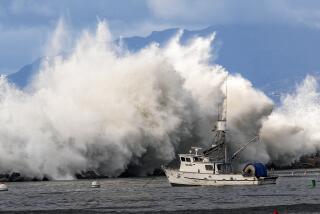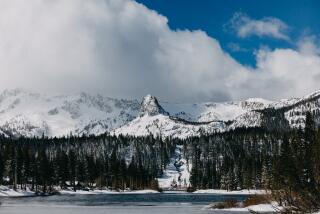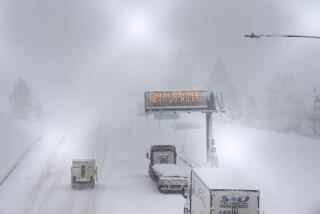It’s critical El Niño hits Northern California. Why experts are growing optimistic.
- Share via
It’s the middle of the summer, but it felt a bit like winter in the Sierra this week as a storm dumped four inches of hail on Interstate 80 around Donner Summit.
There was so much pea-sized ice that the California Highway Patrol on Tuesday halted traffic and called out snowplows — known as the “Sierra Snowfighters” — for help.
SIGN UP for the free Essential California newsletter >>
“It looked just like snow, a blanket of snow across all the lanes,” said California Department of Transportation snowplower John Wheeler. “It was really weird.”
The hail storm was just the latest strange weather to hit the Sierra Nevada, influenced by the weather-changing phenomenon El Niño. For months, climate scientists have said El Niño is likely to bring more rain to Southern California this winter.
But here’s the big question in a state enduring four years of severe drought: How far north will El Niño’s influence roam?
The El Niño hitting the mountains of the north is critical because California’s vast waterworks rely on rain and snow from the Sierra to supply farms and cities. By contrast, much of the rain that falls in Southern California ends up in the ocean.
Experts are becoming more optimistic about El Niño’s northern reach.
Only three months ago, all of California had an equal chance of a wet or a dry winter. But in May, the scales began to turn in favor of a wet winter.
By June, the official forecast by the National Oceanic and Atmospheric Administration predicted that both Southern California and the San Joaquin Valley would be in a region where odds favored wet conditions. Last week, the line moved north again, and San Francisco was included.
Still, the area north of San Francisco, where California’s largest reservoirs — Shasta Lake and Lake Oroville — sit, has an equal chance of a dry or wet winter.
That could change if El Niño continues to muscle up, enabling storms to elbow into the north. That’s what happened during the two biggest El Niños on record, in 1982-83 and 1997-98.
“If this El Niño continues to strengthen, it would not surprise me to see … all the lines extend farther north,” bringing the far reaches of the state into a zone where odds favor a wet winter, NOAA Climate Prediction Center Deputy Director Mike Halpert said.
El Niño can shift the so-called subtropical jet stream from the jungles of southern Mexico and Nicaragua north, over Southern California and the southern United States, said Bill Patzert, a climatologist with NASA’s Jet Propulsion Laboratory in La Cañada Flintridge.
“The really big El Niños — we’re not there yet — can soak the whole state. But right now, it’s possible to get a lot of flooding and mudslides in the south. In Northern California, you could get below-normal rainfall and snowpack,” Patzert said. “So that’s why I’m not calling this a drought-buster yet.”
But even if storms pelt the north, as Stanford University climate scientist Daniel Swain expects they will, El Niño may not give California the drought relief many people might expect.
Much of the eastern Pacific Ocean is experiencing exceptionally warm temperatures, which could produce storms that dump far more rain than the usual mix of rain and snow, which can sit in the mountains for months before melting and trickling into reservoirs.
Too much rain all at once could force water to be flushed out to sea to keep dams from overflowing, and “there’s no way we can possibly store all of the water,” Swain said.
Lifelong residents in the mountain communities around Lake Tahoe have been talking about the weather for weeks. It has caused many to think back to the biggest El Niño year on record, 1997-98, when rains flooded homes along the Truckee River.
The amount of cumulative hail so far in July has been impressive, said Scott McGuire, a meteorologist in the National Weather Service’s Reno office.
“We’ve certainly had more moisture in our region than we typically do,” McGuire said, adding that El Niño “is definitely playing a role. It provides fuel for the atmosphere.”
In early July, thunderstorms forced tourists from boats on Fallen Leaf Lake and suspended gondola rides at the Heavenly ski resort in South Lake Tahoe. Snow fell in the eastern Sierra, coating mountains east of Yosemite National Park. In Truckee, a Fourth of July rainstorm that caught locals by surprise was intense and relentless.
The morning started off warm and sunny, with many in shorts watching the city’s parade. Then suddenly people were running from Donner Pass Road into the Chamber of Commerce building, where they stood sopping wet until the storm passed.
“They were just like, ‘Wow, it never rains on the Fourth of July,’” said Paola Cruz, 19, a welcome center concierge for the Truckee Donner Chamber of Commerce. “The tourists are like, ‘Why is it raining? It’s supposed to be summer.’ I tell them we need water.”
The summer storms have come after an exceptionally dry and snowless winter, painful for a place where skis and snowboards are the lifeblood. Ski resorts had to make their own snow to keep their doors open.
“The ski resorts had to close earlier than they had ever closed before,” Cruz said. “We had people coming in to ski, but it just wasn’t the same.”
CHP Officer Pete Mann, 32, who has lived most of his life near Truckee, said that Tuesday’s hailstorm was the talk of the town, and that it has prompted hopes for the winter.
“We live up here for a reason. We like living in the snow,” Mann said. “If this is El Niño, if this is a sign of things to come, we’ll take it.”
Mann said that when he got home Tuesday night, he had to clear about three inches of hail that had accumulated on his deck. There was still some there Wednesday morning.
“It’s always funny when you come home late at night and you have to shovel the deck in July,” he said.
Hoy: Léa esta historia en español
[email protected]
Twitter: @haileybranson
[email protected]
Twitter: @ronlin
ALSO:
California’s powerful and influential air pollution watchdog
California can’t stop global warming alone, but it can fix its highways
Gov. Brown blasts climate change ‘deniers’ during Vatican conference
More to Read
Sign up for Essential California
The most important California stories and recommendations in your inbox every morning.
You may occasionally receive promotional content from the Los Angeles Times.












